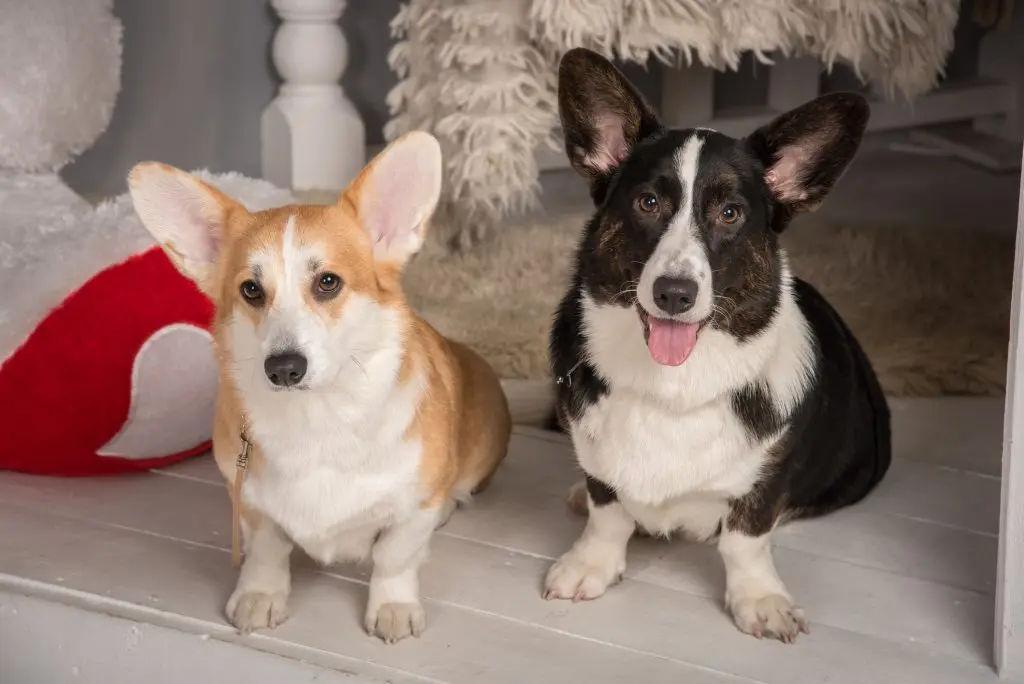Beagles and Corgis are medium-sized dog breeds, bred for a particular purpose, and are highly popular as pets and companions. Whether you are looking to bring one of these animals into your home or are just interested in learning more – here are some of the similarities and differences between these dogs.
While each of these breeds was designed for a different purpose, their generally friendly temperament makes them excellent companion dogs. They are high energy and need both mental and physical exercise. They also require regular grooming. Beagles are usually more friendly toward other dogs and typically do well with multiple dogs. On the other hand, Corgis generally are best as single dogs or paired with a dog of the opposite sex.
The rest of this article will explore the similarities and differences between these breeds, starting with their origins and purpose. Beagles, as well as both types of Corgis, originated in England but were bred for very different tasks.
Table of Contents
Beagles

Beagles were initially bred to be hunting hounds, designed to hunt rabbits and larger hares; this was known as “beagling.” They have keen noses and single-minded tracking instincts. In the past, they were usually kept in packs. Usually, a minimum of three beagles were used while going on a hunt. However, the typical amount was a pack of five to twelve. Nowadays, they are used as detection dogs for prohibited agricultural items, among other things.
There are two different varieties of beagles:
- The 13″ beagle
- The 15″ beagle
This distinction comes from their height at the shoulder. (For the purposes of this article, “beagle” refers to both types unless otherwise stated.)
Corgis

Corgis, on the other hand, were bred for herding cattle. Their short legs helped them stay below the cattle’s kicks and be able to run through their legs if needed. Their height also makes it easier for them to nip at the ankles of the cows or sheep should they get a stubborn one. There are two different breeds of Corgis:
- Pembroke Welsh Corgi
- Cardigan Welsh Corgi
While many people think these two breeds came from the same stock, they are actually two very different and distinct breeds that were initially bred from different dogs and at different times. The Cardigan Welsh Corgis are the much older of the two breeds. The main differing characteristics between these two Corgis are:
- Size
- Friendliness
- Tail
- Coloring
Cardigan corgis are slightly bigger in body and ear than the Pembroke. A fully grown male Pembroke will weigh up to 30 lbs, and a Cardigan will weigh up to 38 pounds. The Pembroke is typically the more outwardly friendly of the two, ready to jump in at a moment’s notice. While Cardigans seem to be more reserved at first, but then quickly warm up to the situation. Additionally, the Pembroke’s tail is docked, while the Cardigan’s is not. Lastly, Cardigans come in a wider variety of colors.
(For the purposes of this article, “corgi” will refer generically to both types unless stated.)
Similarities Between Beagles & Corgis
There are mainly five similarities that can be found between beagles and corgis, including:
- Energy Level
- Behavioral Issues
- Grooming Needs
- Feeding & Exercise
- Trainability & Intelligence
Energy Level
Beagles and corgis are all active and intelligent breeds that need a lot of stimulation to satisfy their instincts. Exercise for both the mind and body is essential to keep these dogs engaged and prevent the formation of bad habits.
Beagles and Corgis will do well with regular walks and playtime activities. They also love attention, so the more affection you can share with them, the happier they will be. However, they can also be stubborn. This attitude can make them endearing, but also needs to be tempered by proper training.
Due to these qualities, these breeds will make fun dogs to have that are typically kid-friendly. Their excessive energy is great for kids, and their intelligence allows them to be trainable, as long as you have patience. This is a great combination to give children as it will not only give them a loyal friend but also experience in helping train and care for a pet.
These breeds are also both quite loyal to their owners. They love being included in family activities such as camping trips, picnics in the park, and even hanging out at home. Pets, cuddles, and quality-time spent will get you far with these breeds.
Behavioral Issues
It is essential to understand the various behavioral issues of these two breeds, especially if you are looking at adding one to your home. Since these dogs tend to be very social, behavior issues could arise if the dog is left alone for too long, and boredom takes over. It is a good idea to take the dog for a long walk, or have ample playtime before leaving them alone. Also, providing them chew toys, or a tv or radio on in the background while you are away will help keep them occupied.
Bored dogs often turn to excessive barking or howling if they are lonely. While Beagles are more avid barkers than Corgis typically are, it’s not to say that Corgis won’t start barking should they feel the need. The barking could become an issue if left unchecked for too long. These dogs use barking to communicate loneliness, desire for food or attention, or the fact that strangers are approaching.
Grooming Needs

Corgis and Beagles are enthusiastic shedders. As these breeds originated in a cold, wet climate, they have undercoats. Due to this, they experience two major shedding times: during spring and autumn. Corgis have a much thicker undercoat and will likely require brushing more often than Beagles. It is recommended that you brush them regularly using an undercoat brush such as the Furminator. Make sure to get a good vacuum cleaner because you may be using it a lot!
It is also suggested that you brush their teeth regularly as dental disease is seen in 80% of dogs by the age of two. It can lead to more severe problems like infection, loss of teeth, or damage to kidneys, liver, heart, and joints. This is easiest if you start the routine while they are puppies, so the habit is engrained. You can begin this on older dogs as well, but it may take more patience and treat rewards.
Feeding & Exercise
Beagles and corgis are both typically food-motivated and love to eat. This can lead to weight gain if they are not adequately exercised. Obesity in dogs can also lead to diabetes, which is common in food-loving dogs. Since both beagles and corgis have good stamina and energy, long walks or playtime helps maintain a healthy weight.
These dogs do better in a house that includes a fenced yard. This will allow them to play and explore, providing both mental stimulation and exercise. If these dogs were to live in an apartment, at least a 1-hour walk should be done every day to ensure adequate exercise.
Trainability & Intelligence
As mentioned before, these breeds are very intelligent and enjoy mental stimulation. You can use interactive dog toys or treat dispensers to help keep your beagles and corgis entertained. This intelligence also means that they can quickly learn commands – if you can get past their natural stubbornness!
The ability to learn quickly can go both ways with these dogs. Consistent training will not only allow you to teach them tricks but also instill good behaviors. However, neglect or reinforcing lousy behavior will also be retained. Since these dogs hold a high level of creativity, they are good at figuring out how to get what they want! The best course of action here is to have patience and stick to rewarding good behavior only.
Due to their food-motivated nature, small treats will help with training. It is also a good idea to start training in a quiet environment free from distractions that could entice these breeds’ natural curiosity. Training sessions should be short and positive to ensure better results. You should start training both these breeds as puppies to gain their trust better and help combat their breed-typical stubbornness!
Differences Between Beagles and Corgis
Although both beagles and corgis share many similarities, they also have a few differences, such as with:
- Temperament
- Appearance
- Interaction with Other Dogs
Temperament
Due to the original purpose of these breeds were developed for, they do have some differences in temperament.

Beagles are hounds, which means they are very scent driven. This may cause stubbornness and difficulty in recall due to their single-minded desire to explore smells. Sometimes this is means that they may not be as focused on listening to you, but rather on a scent they picked up from down the street.
In other words, when beagles lock onto an interesting scent, they may forget all about you while their singlemindedness kicks in. They can go far if you let them, which is why you should have a leash on your Beagle at all times if you are outside of a fence. Their ‘hunting’ has often led to the owner having to run or drive miles to catch their dog!
Corgis, on the other hand, are herding dogs and use sight to stay alert and aware. This herding instinct might show through when the corgi tries to herd smaller pets or children. They usually do this by blocking and trying to ‘steer’ them, or by being “mouthy,” which refers to nipping at the heels/ankles. It is recommended that this behavior is trained out early on to prevent a lifelong bad habit.
However, because corgis are more human-oriented, they will become your willing accomplice. In my personal experience, once you break the herding part, they tend to look at themselves as guardians of the kids and become protective of them.
Appearance
One of the most apparent differences between beagles and corgis is their appearance, as they each have a very distinct look.
Beagles are typically taller and shorter in the body with floppy ears. A male beagle can weigh 22-25 pounds and be as tall as 16″. They come in a wide variety of colors, though not all are officially recognized. Finding a solid-colored beagle is rare since they usually come in 2 or 3 color varieties. The beagle colors are:
- White
- Lemon
- Brown
- Blue
- Red
- Black
- Bluetick
- Redtick
The tri-color variants, which are the most popular, come in 3 varieties:
- Classic tri-color/black back: Black, tan, and white, dark black saddle
- Faded tri-color: Faint black markings intermingled with brown
- Dark tri-color: Mostly black with faded brown markings
On the other hand, Corgis are shorter in height (from 8.9-13″ tall), with longer bodies. They can weigh anywhere from 22lbs for a Pembroke female to 37lbs for a Cardigan male.
Corgis also have pointed ears and a longer snout. They come in a range of colors.
Pembroke Welsh Corgi colors can be:
- Red
- Red-headed tricolor
- Black-headed tricolor
- Sable
- Fawn
Cardigan Welsh Corgi colors can be:
- Red
- Sable
- Fawn
- Brindle
- Black & Brindle
- Blue Merle
- Black & Tan
Interaction with Other Dogs
Since beagles were bred to hunt in packs, they have a very mild disposition to other dogs. Generally, they will be non-aggressive and overall enjoy the pack life. A single beagle may struggle with feelings of loneliness unless their human family is around most of the time.
Corgis can exhibit more aggression to other dogs, specifically males. Cardigan corgis have an even more difficult time interacting with other dogs, especially if they were not raised in that environment. That being said, they can adapt to the pack lifestyle if they are trained at an early age. Socializing them will produce a confident and well-adjusted corgi and ensure they will be able to interact with other dogs throughout their life. Typically, they seem to do better with one of the opposite sex, no matter the breed. Two males (especially intact) have been known to fight. Two females (especially intact as well) have been known to not only fight but have much more bloody fights resulting in more significant injuries or even death.
Health and Lifespan
Beagles are generally healthy dogs, though they can be prone to certain conditions (see below). Their floppy ears can cause ear infections if they are not regularly cleaned and inspected. Also, beagles are highly susceptible to dental disease, which is why regular tooth-brushing or dental cleanings are recommended. A Beagles’ average lifespan is around 15 years.
Possible conditions beagles are prone to are:
- Intervertebral disc disease (IVDD): a slipped or ruptured vertebral disc
- Glaucoma, cataracts, distichiasis (hairs growing inside the eyelid)
- Diabetes
- Hemophilia (bleeding disorder)
- Neurologic problems (Balance issues, seizures, tremors, excessive sleeping)
- Beagle Pain Syndrome: Inflammation of blood vessels
- Liver disorders
- Heart Disease
- Hyperadrenocorticism (Cushing’s)
- Hip dysplasia
- Amyloidosis
- Allergies that cause itchy skin (atopy)
- Bladder and Kidney stones
To read about these disorders and more, check out this article by the American Health Center for Dogs and Cats.
Corgis also do not have that many health problems, though again, they are prone to similar disorders as beagles. Due to their short legs an elongated back, they can be prone to injury if they jump on tall furniture or steep stairs. Some owners get pet stairs to allow the corgi access to taller surfaces. Corgis have slightly shorter lives than beagles, with an average of 12-15 years.
Possible disorders affecting corgis are:
- Intervertebral disc disease (IVDD)
- Canine hip dysplasia (CHD)
- Epilepsy
- Degenerative myelopathy
- Lens luxation
- von Willebrand’s Disease (vWD)
- Progressive retinal atrophy (PRA)
- Urinary stones
To read more about these disorders, check out this article from Canna-Pet.
Both Corgis and Beagles are prone to obesity and diabetes, so keep an eye on their weight. As these two conditions can lead to further problems with joint mobility or organ function, it is essential to keep your pup at the proper weight!
Adopting a Beagle or Corgi
While both beagles and corgis are quite popular in the United States, the Beagle is slightly more so. In 2019 they took sixth place out of 193 dog breeds for their popularity rating. Corgis, on the other hand, are 18 of 193 for the Pembroke Welsh Corgi and 69 of 193 for the Cardigan Welsh Corgi.
The average price for pure-breed Beagle pups is between $400-$1000. Corgis are a bit higher-priced, from $600-$1000, though some can go for as much as $2000. Cardigan Welsh Corgis are usually more expensive because they are less common than the Pembroke Welsh Corgi.
You can also find these breeds at breed rescues and shelters, so check there as well! Additionally, it is always possible to adopt dogs from a breeder that did not meet the breed standard well enough to show. This doesn’t mean that they are less healthy dogs, just that they do not meet the American Kennel Club’s specification for coloration or body size/shape. A mismarked or fluffy Corgi is an excellent example of this.
If you would rather an older dog, look for a shelter near you, go to a purebred rescue, or check out Petfinder.com.
Conclusion
Beagles and Corgis are enthusiastic, happy dogs that enjoy companionship. They will provide you with significant years of fun and activity, so they are great for couples and families on the go. They have amicable personalities and can be trained to get along with most other dogs.
Just keep an eye on their health, practice proper feeding and exercise habits to keep these dogs active and trim. Regular vet visits will help keep an eye out for possible health problems and let you get anything treated that needs to be in a timely manner.
If you are interested in adopting one of these dogs, the only hard choice will be this: do you want a scent-hound or a herding dog? If you are not sure, try assessing the similarities and differences between beagles and corgis that we have mentioned above. Once you determine the breed that is right for you, look for a responsible breeder or check out local shelters and rescues to find the perfect companion for you and your family!




